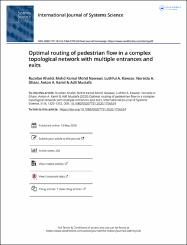| dc.contributor.author | Khalid, Ruzelan | |
| dc.contributor.author | Nawawi, Mohd Kamal Mohd | |
| dc.contributor.author | Kawsar, Luthful Alahi | |
| dc.contributor.author | Ghani, Noraida Abdul | |
| dc.contributor.author | Kamil, Anton Abdulbasah | |
| dc.contributor.author | Mustafa, Adli | |
| dc.date.accessioned | 2023-09-11T20:15:23Z | |
| dc.date.available | 2023-09-11T20:15:23Z | |
| dc.date.issued | 2020 | en_US |
| dc.identifier.issn | 0020-7721 | |
| dc.identifier.issn | 1464-5319 | |
| dc.identifier.uri | https://hdl.handle.net/11363/5493 | |
| dc.description.abstract | A real-world topological network consists of multiple entrances along its source nodes. Routing
appropriate percentages of pedestrians from these entrances to the particular available routes with
relevant arrival rates will improve the network’s performance. This paper presents a framework for
finding the optimal arrival rates of pedestrians from all available entrances and routes to downstream
nodes maximising the network’s throughput. The calculation of the arrival rates and movement
directions is based on M/G/C/C analytical and simulation models and the network flow model and
considers the real distances of the entrances along the source nodes. The framework was tested
on the Tuanku Syed Putra Hall, Universiti Sains Malaysia, Malaysia. Extensive analyses of the performances of its available nodes especially on the achievable optimal throughputs were documented
and discussed. Quantitative results show that the hall’s throughput is optimised when pedestrians’
arrival rates to all the available entrances and their movement directions are controlled within certain
ranges. | en_US |
| dc.language.iso | eng | en_US |
| dc.publisher | TAYLOR & FRANCIS LTD, 2-4 PARK SQUARE, MILTON PARK, ABINGDON OR14 4RN, OXON, ENGLAND | en_US |
| dc.relation.isversionof | 10.1080/00207721.2020.1756524 | en_US |
| dc.rights | info:eu-repo/semantics/openAccess | en_US |
| dc.rights | Attribution-NonCommercial-NoDerivs 3.0 United States | * |
| dc.rights.uri | http://creativecommons.org/licenses/by-nc-nd/3.0/us/ | * |
| dc.subject | M/G/C/C | en_US |
| dc.subject | network flow model | en_US |
| dc.subject | simulation | en_US |
| dc.subject | facilities planning and design | en_US |
| dc.subject | queuing networks | en_US |
| dc.title | Optimal routing of pedestrian flow in a complex topological network with multiple entrances and exits | en_US |
| dc.type | article | en_US |
| dc.relation.ispartof | International Journal of Systems Science | en_US |
| dc.department | İktisadi İdari ve Sosyal Bilimler Fakültesi | en_US |
| dc.authorid | http://orcid.org/0000-0002-4283-0737 | en_US |
| dc.authorid | http://orcid.org/0000-0003-4447-9941 | en_US |
| dc.authorid | http://orcid.org/0000-0002-8010-6379 | en_US |
| dc.authorid | http://orcid.org/0000-0001-5410-812X | en_US |
| dc.authorid | http://orcid.org/0000-0003-0989-674X | en_US |
| dc.identifier.volume | 51 | en_US |
| dc.identifier.issue | 8 | en_US |
| dc.identifier.startpage | 1325 | en_US |
| dc.identifier.endpage | 1352 | en_US |
| dc.relation.publicationcategory | Makale - Uluslararası Hakemli Dergi - Kurum Öğretim Elemanı | en_US |
| dc.institutionauthor | Kamil, Anton Abdulbasah | |



















